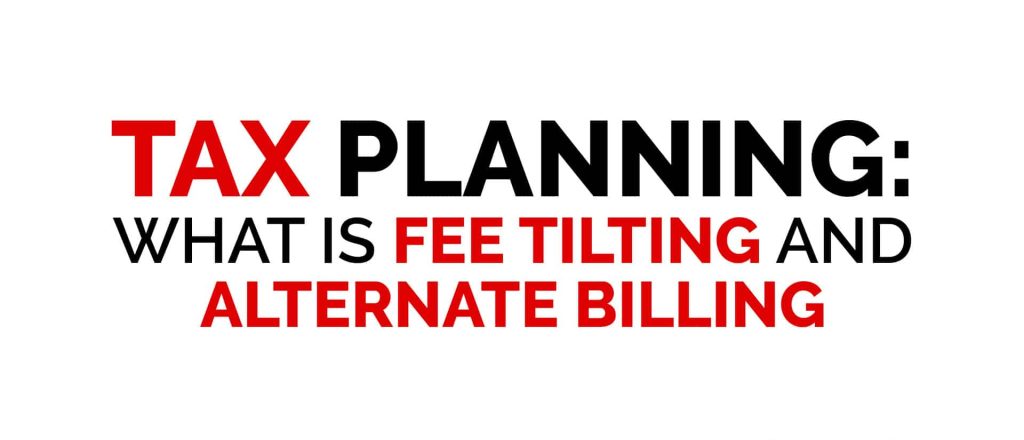The Setting Every Community Up for Retirement Enhancement (SECURE) Act of 2019 introduced a number of changes to the retirement account planning landscape. One of the most notable changes was the elimination of the ‘Stretch IRA’ and the introduction of the 10 year rule for non-eligible designated beneficiaries.
For savers who are in the fortunate position of having a healthy or even overfunded retirement account a number of smart tax moves can be utilized to maximize your asset value including Roth conversions, Qualified Charitable Distributions, and the topic of this post – Fee Tilting and Alternate Billing.
Fee Tilting
Prior to 2018, investors had the ability to deduct the fees that they paid their financial advisor. Following the elimination of this tax break with the Tax Cuts and Jobs Act the focus shifted on utilizing high valued Traditional IRA accounts as a tax efficient way to pay your advisory fee to effectively obtain a deduction on the fee paid (as this is not a taxable event.
To maximize this benefit, a tax savvy advisor can tilt the fees that they charge to increase the percentage of the advisory fee being taken from a pre-tax retirement account and creating a bona fide tax break while subsequently reducing the fee charged in the taxable account to avoid an increase in overall fees charged to the client.
Example: Bob has a $500,000 taxable investment account and a $500,000 IRA account and would like to utilize fee tilting to pay his fees as tax efficiently as possible. If Bob paid a hypothetical advisory rate of 1% across the board he would pay $5,000 from his taxable account and $5,000 from his IRA account annually.
Alternatively, if his tax savvy advisor were to tilt the fees so that he paid 0.5% from his taxable account and 1.5% from his IRA account he still pays the same $10,000 per year however only $2,500 comes from his taxable account while $7,500 comes from his retirement account income tax free.
Alternate Billing
Alternate billing is the practice of applying your account fee to an alternate account. While you can’t pay your account bills all from your IRA (i.e. pay for taxable or Roth account fees from your IRA) you can establish alternate billing to pay your Roth IRA fee from your taxable account.
With a Roth IRA account, the funds are tax free forever (assuming holding and age requirements are met) and the goal should be to remove any friction that would keep it from compounding as much as possible. By taking your management fee and having it billed to an alternate account a tax savvy advisor can remove the friction an account fee can cause and increase the compounding nature of the account.
Example: Bob from before also has a $500,000 Roth IRA and would like to utilize alternate billing in addition to fee tilting to get the maximum benefit from tax conscious billing strategies. A hypothetical fee might be 1% across the board ($15,000 in total fees on his $1.5 million portfolio) while a tax savvy advisor might charge 0.5% on the taxable account and include an alternate billing approach on the Roth IRA while also charging a 1.75% fee on the IRA. In this scenario, $5,000 would be charged against the taxable account (0.5% charged against the $500,000 taxable account and the $500,000 Roth IRA – both paid from the taxable account) and $8,750 from the IRA tax free (1.75% charged against the 500,000 IRA account) while no fees are taken from the Roth IRA for a total fee of $13,750.
Would you like to understand whether the content discussed in this post is appropriate for you and how it may fit in to your overall financial plan? Schedule an introductory phone call with our team here.
Disclosure: This case study is for illustrative purposes only. Individual cases will vary. Any information is not a complete summary or statement of all available data necessary for making an investment decision and does not constitute a recommendation. Prior to making any investment decision, you should consult with your financial advisor about your individual situation. Any opinions are those of the author and not necessarily those of Raymond James.
Please note, changes in tax laws may occur at any time and could have a substantial impact upon each person’s situation. While we are familiar with the tax provisions of the issues presented herein, as Financial Advisors of RJFS, we are not qualified to render advice on tax or legal matters. You should discuss tax or legal matters with the appropriate professional.
In a fee-based account clients pay a quarterly fee, based on the level of assets in the account, for the services of a financial advisor as part of an advisory relationship. In deciding to pay a fee rather than commissions, clients should understand that the fee may be higher than a commission alternative during periods of lower trading. Advisory fees are in addition to the internal expenses charged by mutual funds and other investment company securities. To the extent that clients intend to hold these securities, the internal expenses should be included when evaluating the costs of a fee-based account. Clients should periodically re-evaluate whether the use of an asset-based fee continues to be appropriate in servicing their needs. A list of additional considerations, as well as the fee schedule, is available in the firm’s Form ADV Part 2 as well as the client agreement.




